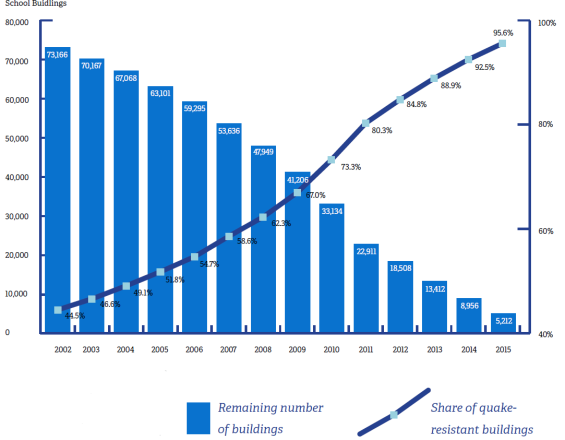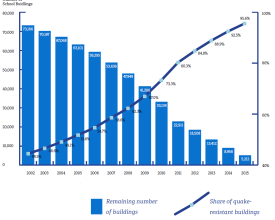
Safer Schools

Located in the circum-Pacific mobile belt, Japan is highly exposed to earthquake hazards due to constant seismic and volcanic activity. To ensure safety of school children, teachers, and communities, the Japanese Government initiated the “Program for Earthquake-Resistant School Buildings” in 1978 to promote retrofitting of public schools to improve their earthquake-resistance capacity. Despite the slow progress during the first two decades due to institutional, legal, and financial challenges, in the last 13 years, the country made tremendous progress in seismic resilience by developing new and revised earlier policies, building standards, and other guidelines to help manage the impacts of seismic events, including the retrofitting of school buildings. Through collaborations with local municipalities, the Japanese government has reached a 95.6 percent rate of retrofitting of school infrastructure as of April 2015.
Context
Challenges addressed
In Japan, schools are a place for both student education and local community activities and evacuation during disaster. Consequently, there was a need to evaluate and retrofit reinforced concrete school buildings constructed before 1981 if they did not meet the new building regulation standards. According to an evaluation by the Japanese government, 88,000 schools were built before 1981 nationwide, which MEXT responded to by urging local governments to enhance schools’ earthquake resistance through seismic diagnosis and retrofitting in 1996. Despite this, progress by municipalities was slower than anticipated, and in the year 2002 surveys by the Fire and Disaster Management Agency (FDMA) concluded that only 44.5% of all existing school buildings had been confirmed as earthquake-resistant and 31% of the 88,000 schools had completed seismic diagnosis. Accordingly, it was necessary for MEXT to implement appropriate measures to speed up retrofitting and diagnosis to reach 100% achievement.
Location
Process
Summary of the process
Japan has taken each disaster as a learning opportunity to improve and update its system and policies to increase the resilience of schools and provide a safer environment for school children and communities. Investigations and analysis regarding each disaster were conducted to obtain data and to identify the priority areas of work in terms of location and measures to achieve the goals of the “Program for Earthquake-Resistant School Buildings”. Based on these studies and analyses, the national government determined the best ways to financially support local municipalities overcome their implementational problems and pushed the progress of the program in achieving its goals. As a result,, the country was able to accomplish a 95.6 percent completion rate (74,788 schools out of 80,000) in just 13 years.
Building Blocks
Building on experiences
One of the biggest instigators for developing and promoting school retrofitting is the past experiences of earthquakes. The 1995 Great Hanshin-Awaji Earthquake triggered the development of the program’s comprehensive guidelines, and the program gained momentum after the 2004 Chuetsu Earthquake and 2008 Sichuan Earthquake in China which caused the collapse of 6,898 school buildings and 19,065 deaths of schoolchildren. This prompted MEXT officials to pass the revised Act on Special Measures for Earthquake Disaster Countermeasures, which supported additional national subsidies toward the school retrofitting and reconstruction program. The 2011 Great East Japan Earthquake prompted the program to give higher priority to nonstructural elements and highlighted the need for tsunami countermeasures and functional improvements of schools as evacuation centers. Learning from each disaster event and applying the lessons learned to the improvement of the systems has contributed to ensuring the seismic safety of public schools.
Enabling factors
- Identification of the need to prioritize the subject through national policy.
- The political will to make improvements to policies to achieve a goal.
Lesson learned
Political will and interest to identify the retrofitting of schools as a priority initiative was essential for the national government to take measures to improve its systems and policies building on experiences. The constant effort to promote the retrofitting program was in part induced by politicians’ interest in both humanitarian and economic reasons. In a culture that prioritizes human life, a policy for making schools earthquake-resistant has the aim of saving the lives of schoolchildren. The policy also is considered an effective investment that contributes to local economies and produces tangible results that are well-received by the public.
Availability of Data
Three types of data were particularly important in the design and promotion of the “Program for Earthquake-Resistant School Buildings”: school data, data on damages, and data on hazard risks. School data was collected by surveys and investigations conducted by FDMA and MEXT. A list of the surveys is indicated below.
Enabling factors
- School Basic Survey (annually since 1948) to collect basic data.
- Public School Facilities Survey (annually since 1954) to collect building area and conditions of school facilities.
- Status of Seismic Resistance of Public School Facilities (annually since 2002) to collect data on the seismic resistance of school structures as well as suspended ceilings of gymnasiums and other nonstructural elements of school buildings.
Lesson learned
Earthquake Damage Investigation (after each mega-disaster such as the Great Hanshin-Awaji Earthquake and the Great East Japan Earthquake) to collect damage to buildings, specifically the kind of damage suffered by various types of buildings, the location where the damage occurred and under what circumstances, and the kind of earthquake that caused the damage.
Financial support by national government and schemes to reduce financial burden of local governments
The national government provides local governments with additional subsidies for seismic retrofitting and reconstruction of schools with insufficient seismic capacity. In principle, national subsidies for retrofitting and reconstruction cover one-third of associated costs for public elementary and junior high schools, but the national share has been raised to two-thirds and one-half respectively in 2008 under the Act on Special Measures for Earthquake Disaster Countermeasures. Furthermore, additional sources of funding were generated through local bonds and local tax allocation by local governments. In Shizuoka prefecture, located in the Tokai area where earthquake probability is high, the local government increased corporate income tax by 7-10 percent for 15 years to allocate budget for making public buildings more earthquake resistant. Kushiro municipality’s retrofitting completion rate remained at 50 percent for a decade due to lack of funds, however, this increased the rate to 85.8 percent within 3 years of introducing the PFI system.
Enabling factors
- Mutual understanding of stakeholders of the importance of investing in the retrofitting of schools.
- Commitment by municipal governments on the promotion of the program.
Lesson learned
Proactive support by the national government was an essential part in achieving the retrofitting of schools across Japan. Progress to achieve the goal of the program was initially slow due to the financial burden on the local governments. The national government responded by increasing the national subsidies in seismic retrofitting and reconstruction. In addition, when there was difficulty in securing sufficient funding for retrofitting subsidies from the initial national budget, the government explored the use of supplementary budget and reserve fund.
Impacts
Economic
To tackle the problem of the aging of school buildings, the Ministry of Education, Culture, Sports, Science and Technology (MEXT), has started to promote rehabilitation that extends buildings’ life span. Under this initiative, all parts of the building are removed and completely refurnished using the original post and beam as the structure, which costs 30-40% less than conventional reconstruction. This method has the potential to extend the life of the buildings by 30 years or longer.
Environmental
The new rehabilitation initiative mentioned above utilizes original post and beam to refurnish the building parts, therefore reducing the number of new parts to be used. In addition, when the life span of buildings is extended, the implication is that the complete demolition and rebuilding are avoided, decreasing the buildings’ environmental impact as a result.
Social
Throughout the process of reaching school and community's consensus on retrofitting, awareness raising workshops were frequently held by the municipal government, and information was shared on school websites and newsletters for public outreach. As a result, public interest and awareness were raised toward seismic retrofitting of schools and the roles of school staff and communities in maintaining school facilities and equipment for evacuation centers were strengthened.
Beneficiaries
- Local communities and schools.
- School children and staff.

